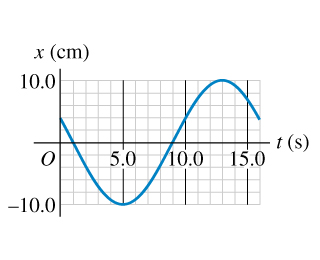
College Physics
11th Edition
ISBN: 9781305952300
Author: Raymond A. Serway, Chris Vuille
Publisher: Cengage Learning
expand_more
expand_more
format_list_bulleted
Concept explainers
Topic Video
Question
Part A
What is the frequency?
Part B
What is the amplitude?
Part C
What is the period?
Part D
What is the angular frequency of this motion?

Transcribed Image Text:x (cm)
10.0
t (s
01 5.0 10.0 15.0
-10.0
Expert Solution
This question has been solved!
Explore an expertly crafted, step-by-step solution for a thorough understanding of key concepts.
This is a popular solution
Trending nowThis is a popular solution!
Step by stepSolved in 6 steps with 5 images

Knowledge Booster
Learn more about
Need a deep-dive on the concept behind this application? Look no further. Learn more about this topic, physics and related others by exploring similar questions and additional content below.Similar questions
- A particle with a mass of 0.1 kg undergoes SHM with an amplitude of 0.05 m. Its maximum acceleration is 10g, where g stands for the gravitational acceleration. What is the period of the oscillation? What is the maximum speed of the particle? What is the total mechanical energy of the particle? What is the magnitude of the force on the particle when it is at 1/3 of its maximum displacement? 2.arrow_forwardThe max displacement from the equilibrium of any oscillator can be doubled by doubling? a. Only the initial speed b. Only the initial displacement C. The initial displacement and the initial speed d. Halving the initial speed while doubling the initial displacement.arrow_forwardA 500g mass is undergoing simple harmonic oscillation that is described by the following equation for its position x(t) from equilibrium: n rad x(t) = (0.50m) cos (6.07 rad/s)t+ 6.0arrow_forward
- There is a web that oscillates horizontally through simple harmonic motion with an amplitude of 2.4 x 10-3 m and a period of 0.42 seconds. 1. What point(s) of the oscillation does the spider experience a magnitude of acceleration. 2. What is the maximum magnitude of acceleration that the spider experiences?arrow_forwardThe equation for the angular position of a pendulum oscillating at small angles is given by Theta(t)= (.15 rad) cos(4.4t +0.32) Part a) find the amplitude in radians Part b)find the phase constant in radians Part c) find the angular frequency in rad/s Part d) find the period in secondsarrow_forward4. After landing on an unfamiliar planet, a space explorer constructs a simple pendulum of length 49.0 cm . The explorer finds that the pendulum completes 90.0 full swing cycles in a time of 145s. What is the magnitude of the gravitational acceleration on this planet?arrow_forward
- 7. A 0.250 kg block oscillates on a spring horizontally on a frictionless surface. The spring has a spring constant of 200 N/m. The amplitude of the oscillations is 24.5 cm. a. What is the period of this mass-spring system (in seconds)? b. What is the maximum speed of the block (in m/s)?arrow_forward5. A block is attached to a horizontal spring. Find a model for the displacement d as a function of time given the following conditions: a. At time t = 0, the block is pulled to the left 6 cm with a frequency of 2 Hz. W -3-2-1 0 1 2 3 + d b. At time t = 0, the initial displacement is 0 inches (moving to the right), the amplitude is 15 centimeters, and the period is 1 sec.arrow_forwardA mass-spring oscillator is created. It has a period of 6 seconds and an amplitude of 2 cm.When a 0.70 kg-object is attached to the spring hung vertically, it stretches 0.15 m from theequilibrium position. (The following questions can be answered in either order depending onmethod )A. What is the maximum speed of the oscillator?B. What is mass hanging in the spring?arrow_forward
arrow_back_ios
arrow_forward_ios
Recommended textbooks for you
 College PhysicsPhysicsISBN:9781305952300Author:Raymond A. Serway, Chris VuillePublisher:Cengage Learning
College PhysicsPhysicsISBN:9781305952300Author:Raymond A. Serway, Chris VuillePublisher:Cengage Learning University Physics (14th Edition)PhysicsISBN:9780133969290Author:Hugh D. Young, Roger A. FreedmanPublisher:PEARSON
University Physics (14th Edition)PhysicsISBN:9780133969290Author:Hugh D. Young, Roger A. FreedmanPublisher:PEARSON Introduction To Quantum MechanicsPhysicsISBN:9781107189638Author:Griffiths, David J., Schroeter, Darrell F.Publisher:Cambridge University Press
Introduction To Quantum MechanicsPhysicsISBN:9781107189638Author:Griffiths, David J., Schroeter, Darrell F.Publisher:Cambridge University Press Physics for Scientists and EngineersPhysicsISBN:9781337553278Author:Raymond A. Serway, John W. JewettPublisher:Cengage Learning
Physics for Scientists and EngineersPhysicsISBN:9781337553278Author:Raymond A. Serway, John W. JewettPublisher:Cengage Learning Lecture- Tutorials for Introductory AstronomyPhysicsISBN:9780321820464Author:Edward E. Prather, Tim P. Slater, Jeff P. Adams, Gina BrissendenPublisher:Addison-Wesley
Lecture- Tutorials for Introductory AstronomyPhysicsISBN:9780321820464Author:Edward E. Prather, Tim P. Slater, Jeff P. Adams, Gina BrissendenPublisher:Addison-Wesley College Physics: A Strategic Approach (4th Editio...PhysicsISBN:9780134609034Author:Randall D. Knight (Professor Emeritus), Brian Jones, Stuart FieldPublisher:PEARSON
College Physics: A Strategic Approach (4th Editio...PhysicsISBN:9780134609034Author:Randall D. Knight (Professor Emeritus), Brian Jones, Stuart FieldPublisher:PEARSON

College Physics
Physics
ISBN:9781305952300
Author:Raymond A. Serway, Chris Vuille
Publisher:Cengage Learning

University Physics (14th Edition)
Physics
ISBN:9780133969290
Author:Hugh D. Young, Roger A. Freedman
Publisher:PEARSON

Introduction To Quantum Mechanics
Physics
ISBN:9781107189638
Author:Griffiths, David J., Schroeter, Darrell F.
Publisher:Cambridge University Press

Physics for Scientists and Engineers
Physics
ISBN:9781337553278
Author:Raymond A. Serway, John W. Jewett
Publisher:Cengage Learning

Lecture- Tutorials for Introductory Astronomy
Physics
ISBN:9780321820464
Author:Edward E. Prather, Tim P. Slater, Jeff P. Adams, Gina Brissenden
Publisher:Addison-Wesley

College Physics: A Strategic Approach (4th Editio...
Physics
ISBN:9780134609034
Author:Randall D. Knight (Professor Emeritus), Brian Jones, Stuart Field
Publisher:PEARSON